How GrubHub's Shadow Website Practice Works and How Local Restaurants Can Improve their Online Presence to Compete
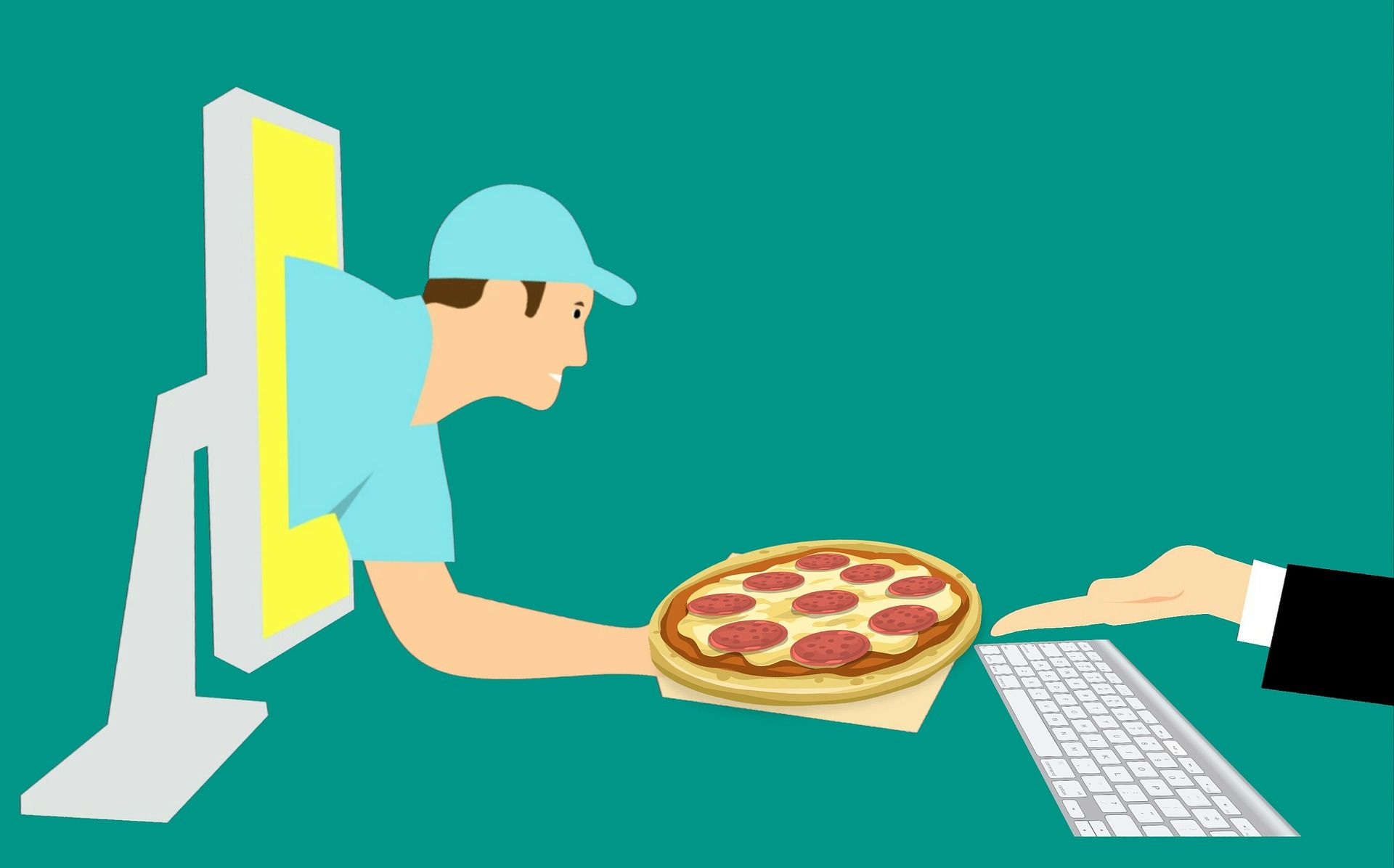
Last year the New Food Economy reported that GrubHub and Seamless have been purchasing domains and creating sites for customers. While that does not sound nefarious, the problem is they did not openly disclose this practice to restaurant owners.
More recently the Gibbs Law Group has opened a class action lawsuit against GrubHub for these ghost sites and listing them on the GrubHub site without permission.
You will learn why this is a problem and how local restaurants can fight back to regain control of their digital and contactless ordering.
This has created problems on several levels because the GrubHub sites compete and confuse customers as they look like a simple site for the restaurant. Next, they use links for online orders and phone calls that provide GrubHub a high commission rate. Up to 20% of the order.
GrubHub is not alone, I have found many other online ordering platforms doing the exact same thing. For example, I found this Eat Street site for Jade Garden down the street from my university in Raleigh NC.
It is the number 1 Bing search result for Jade Garden and its Hillsborough Street address. Jade Garden's actual site is #2.
GrubHub 'marketing' fees often accumulate to thousands of dollars for local restaurants. The practice of creating a pseudo or shadow website shaves traffic from a restaurant's actual website, which leads to orders not subject to the commission overhead. Ultimately this reduces the business' profitability.
The Shadow or Ghost site practice has left many restaurateurs confused and some angry. Others don't mind, but maybe they should be upset.
Quick Facts
- GrubHub and Seamless registered 34,504 domains for restaurants since 2010, 9100+ still active
- They created pseudo sites using the data supplied by their customers
- The sites included links to GrubHub's commission-based ordering platform
- The sites list GrubHub controlled phone numbers that generate commissions
- GrubHub charges commissions between 3-30%
- GrubHub processes roughly 200,000 orders a day
Should restaurant owners be upset, or should they be happy?
What exactly has GrubHub and Seamless done and how did they accomplish the feat?
How exactly does this practice lead customers to unknowingly use the GrubHub ordering platform and GrubHub controlled phone numbers?
How does this affect local restaurant search engine optimization?
What can owners do if they don't want GrubHub and Seamless to siphon sales from their own websites?
GrubHub and Seamless have officially positioned themselves as a marketing and discovery tool for restaurants. They do this with their primary restaurant directory websites for GrubHub and Seamless. They earn revenues by collecting a commission on all orders placed through the GrubHub infrastructure.
Many see GrubHub as a delivery service, but this is a small portion of their overall business and not part of their original model. In a court case concerning the employee status of their delivery agents, GrubHub lawyer Theodore Boutrous, Jr. was asked if GrubHub considers itself to be a “food delivery company.” the official response was “No, we do not.”.
This leaves the company more or less as an affiliate marketing company with some side hustles. Unlike most affiliate programs they dictate the commission structure, which like I stated earlier ranges up to 30% of an order total.
Since most restaurants operate on margins much less than 30% most see themselves losing money on the relationship. A Brooklyn/Queens restaurant owner reported her monthly commissions to GrubHub were over $8000, more than their monthly leases.
The fees charged by GrubHub, Postmates, Eat Street and other online directory and marketing companies seems to be choking the life out of many restaurants. Some try to charge more for orders made through these services but are often met with objections by the marketing services as well as customers.
Ironically, the GrubHub shadow sites were found to inflate menu item prices when ordered through their system. This means the consumer as well as the restaurant pays more. The consumer is obviously affected because the item is more expensive through the third-party system. The restaurant is charged more in the commission since the order amount is higher than it normally would be. 20% of $50 is more than 20% of $45, basic math.
As I read through articles about the practice, I saw many positions, including owners that were not disturbed by the practice. They seemed to be resigned to having no power in the mater due to lack of knowledge of how the web and online marketing work.
I hope to help remove some of the fog obscuring your understanding of what this practice is, how it works and how you, a business owner can put in a little elbow grease to direct customers directly to your own website and online ordering platform.
Defining the Problem
GrubHub is not the first third party marketing company to use this tactic. I remember CitySearch implementing a similar practice in the early 2000s. I know about it because many local businesses were contacting me to create websites for them and wanted to register domains.
A domain is your online address. You must register your ownership of the domain and renew the registration every year. This is sort of like renewing your car's license plate.
If the business had a 'contract' with CitySearch the domains were often already registered and owned by CitySearch. Some knew CitySearch had registered the domain as well as created a simple site. They wanted a more professional presence than what was offered by CitySearch.
Often the CitySearch sites contained incorrect information, logos, location and products. If I recall the sites were farmed out to South East Asia and were more or less milled without much effort. I estimated about 10 minutes was allocated to creating the pages.
At the time CitySearch was vying to replace the classic Yellow Pages, which I have also seen use a similar shadow site practice. They would sign local businesses up with the promise of online traffic. Often misleading business owners that they were the only way consumers could find their business. They would charge a few hundred dollars a month for a listing on the CitySearch directory and these cheesy pseudo sites.
The problem is they would register themselves making CItySearch the domain owner, not the business. Their contract language stated the business owner was leasing the domain from CitySearch.
This meant when the business owner wanted to create a real site the CItySearch registered domain was not available. Sure, they said the owners could transfer the domain, but if I recall there was a hefty fee and of course a lot of steps involved.
They did not want the business to have that domain because it would diminish the need for the overpriced CitySearch marketing services.
The main takeaway here is the practice of a 'marketing' company positioning themselves between consumers and businesses is nothing new.
As I read the stories about the GrubHub shadow site practice the story sounded familiar.
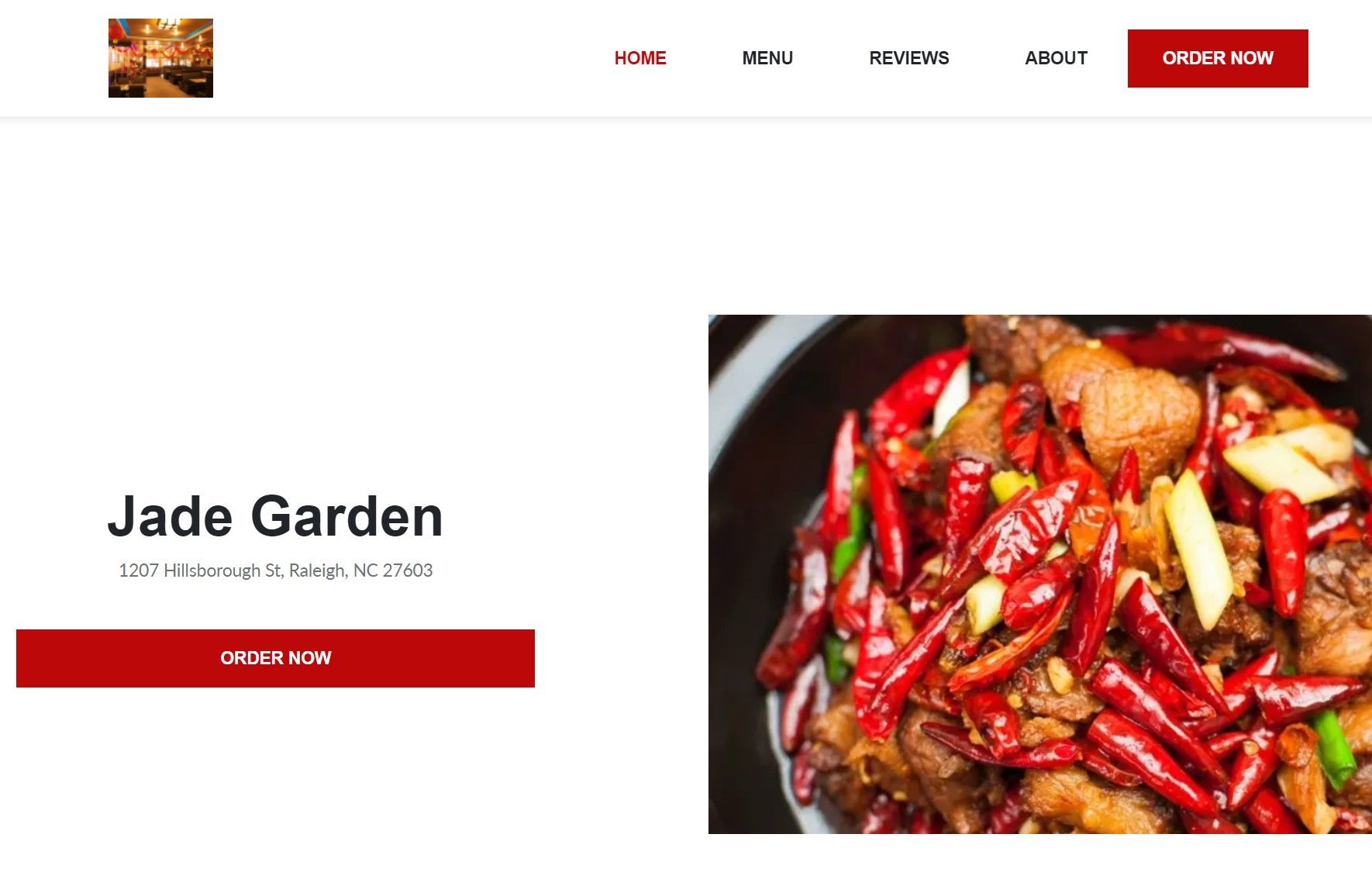
How the GrubHub Shadow Sites Work
While GrubHub's brand has carried weight with many consumers, especially millennials and residents of large cities like New York there is still more potential traffic available through search engines. In an effort to funnel some of the free search engine traffic GrubHub and Seamless registered domains for customer restaurants.
They used the information supplied by the restaurants, menu items, contact, photos and some copy to quickly spin up a site based on a single website template.
The same template is used for every site, which is populated with the data in the GrubHub database. In addition to the restaurant supplied data, GrubHub reviews are listed as well.
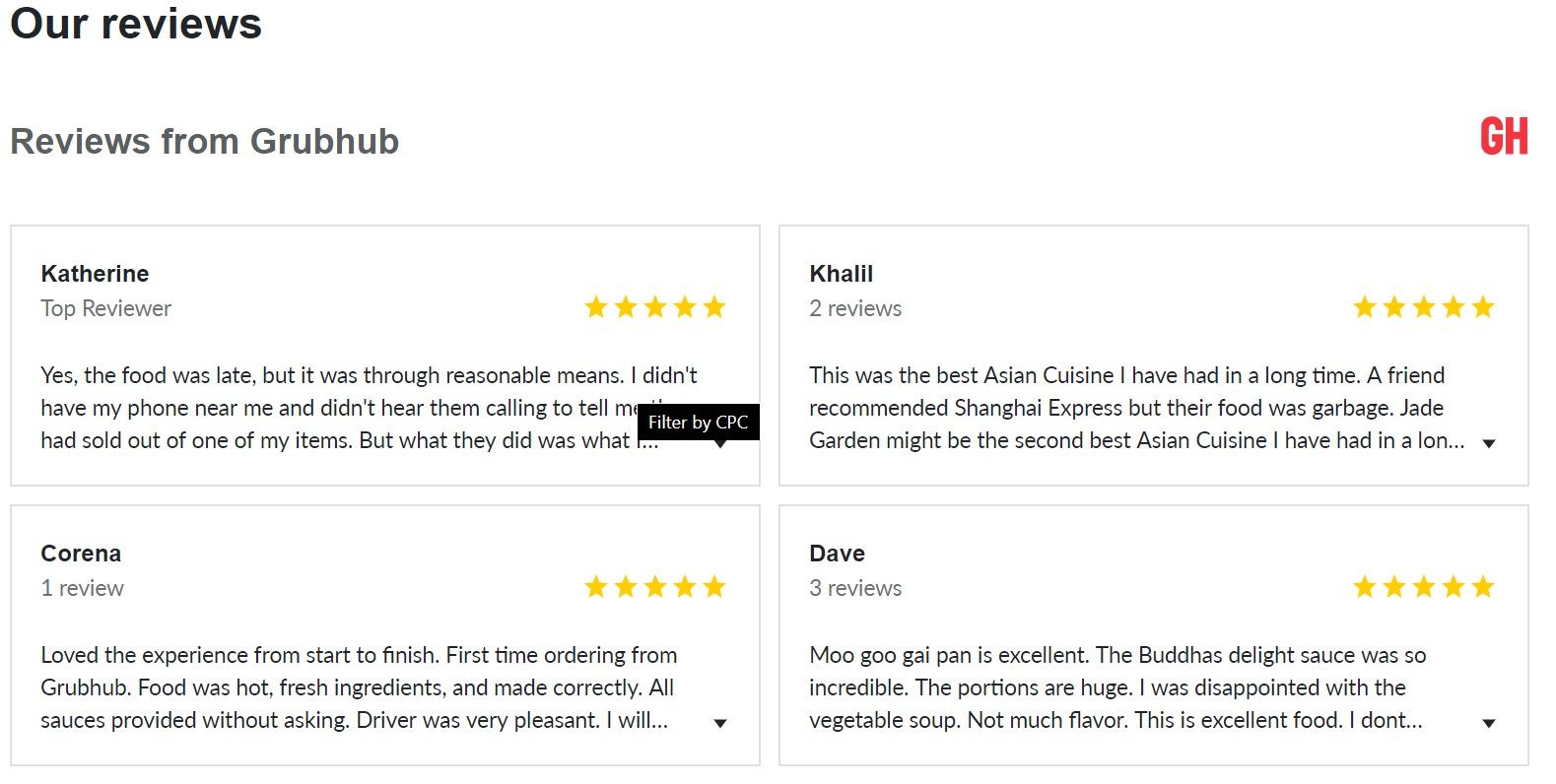
The effort to generate these sites takes less than 5 minutes of automation, so next to nothing for GrubHub. Their biggest overhead is the annual domain registration, which is about $15 retail.
Domain registration wholesale fees range from $5 to over $100 depending on the top-level domain (TLD). A TLD is the suffix, like .com or .net. For the record .com and .net domains cost around $11 wholesale to register.
When you see prices less than $10 for a .com there is always a catch, so always look into where you will be upsold or charged excessively after the first year.
For roughly $15 a year GrubHub has a website that can rank in search results, competing against their own client's website and directing orders to flow through the GrubHub system. By doing this GrubHub can collect high commissions on those orders.
With the shadow sites GrubHub has at least 3 websites that can rank for a specific restaurant: GrubHub's page, the Seamless page and the shadow site.
If you consider the generic searches for dining near a consumer, they have even more potential result stuffers. Not only do they have the GrubHub and Seamless directories they also have a whole army of shadow sites in the area.
All this creates noise to consume as many search results as possible.
Often these sites outrank the real website, which means the majority of traffic funnels through the GrubHub ordering system.
The GrubHub Private Blog Network
Search Engine Optimization has multiple dimensions to earning top search placements. There are many on page and off page factors that come into play.
Backlinks or links from other web pages are still the most important ranking factor. By creating these shadow sites and creating links to the GrubHub platform they are creating artificial authority.
To SEO professionals this is a form of a private blog network (PBN). This is where you create content on a controlled website to point to your money site.
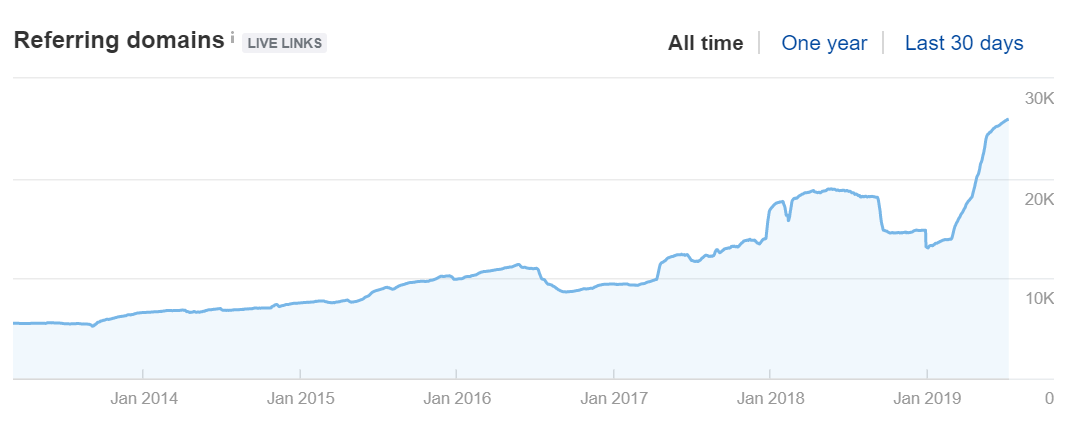
This is a tactic used by many grey and black hat SEOs. It can be a very abused tactic but can also be somewhat legitimate when done ethically. By ethically I mean some sites are designed to be platforms for paid guest posts and can contain some quality content.
Either way, by registering these domains and linking to GrubHub.com URLs (pages on the grubhub.com site) they are creating search equity to inflate the GrubHub site in the eyes of search engines.
This is also known as authority. While it does not directly improve the shadow sites, they do pass link juice to the main site, where GrubHub makes money.
In my sample of these sites I found many of them have inbound links pointing to them. This means they have more authority than other sites.
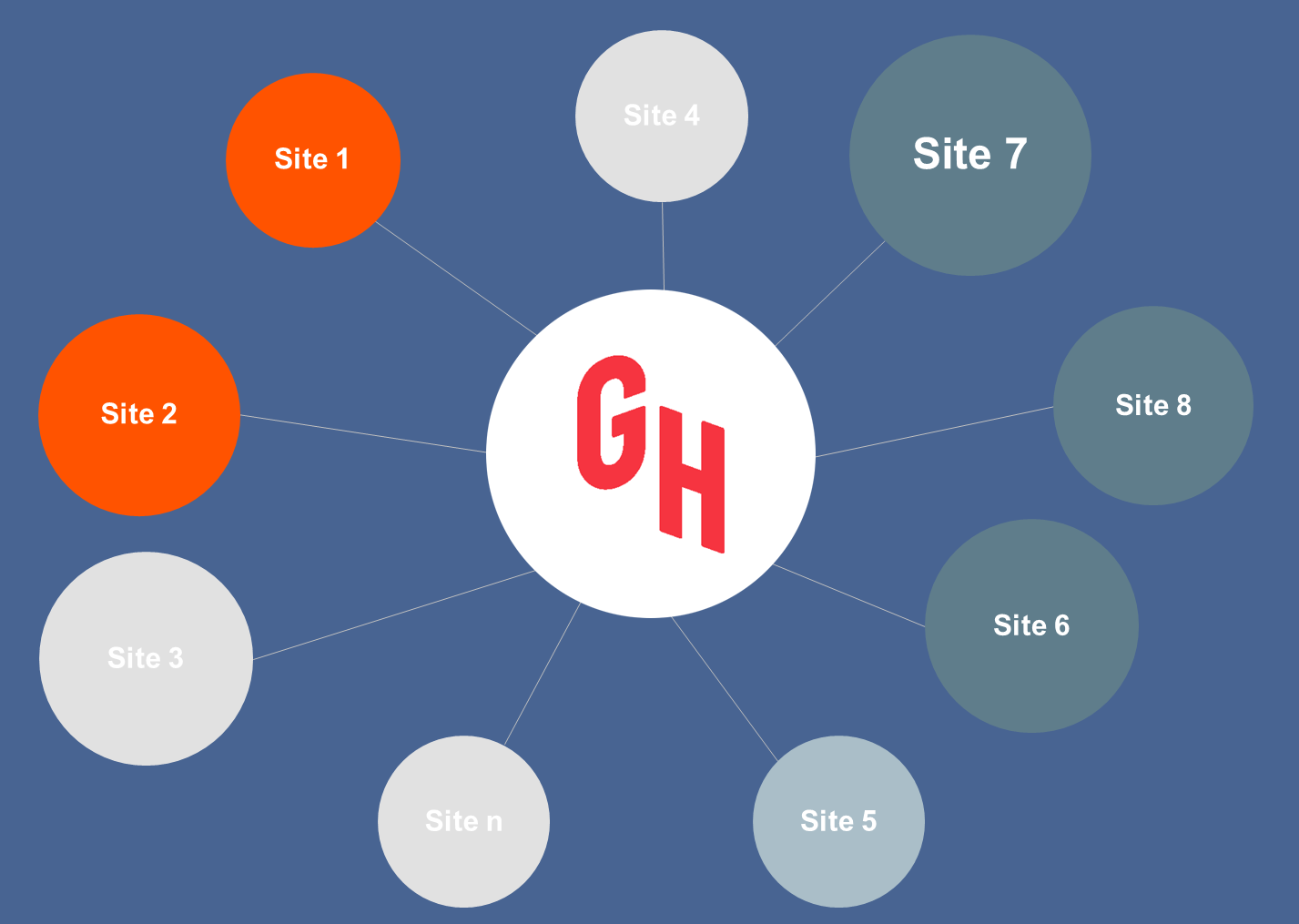
For almost every local restaurant site and the pages referencing that site there is little to no authority since they either have no backlinks or the links they have are weak.
In the end, GrubHub has created some extra authority with their shadow site practice other platforms have not created and certainly the actual restaurant. It makes just a little harder to compete with the goliath.
Phone Order Commissions
Beyond just collecting commissions through online orders, GrubHub also collects commissions through the phone calls it drives.
Since all phone calls do not result in an order GrubHub uses an 'algorithm' to guess at which calls results in an order and how much commission they are owed.
Restaurant owners are expected to listen to all the calls to determine if GrubHub is owed a commission or not.
Who has time for that?
No one.
How does this work?
These shadow sites, as well as the GrubHub listings use a custom phone number the company created that forwards to the restaurant.
These can be created for a few dollars a month. GrubHub can record and audit these calls and automatically generate bills based on activity. What my research uncovered is it is suspected any call over 45 seconds commands a commission.
This practice is not uncommon, even for businesses to do directly. When you create an advertising campaign you want to know if it works or not. Sometimes you use a coupon or coupon code. But you can also use special numbers like GrubHub uses to direct responses.
These numbers make it easier to segregate responses to the campaign from normal activity.
You can think of these numbers, coupons and other markers as tracer bullets to track what promotions are working and which one's aren't. That way you can kill weak promotions and scale those that do.
In marketing this is known as A/B testing and is valuable data to improve a business.
Again you want customers to call you directly, on your real phone number.
This can also cause an issue with search engine rankings, which I will discuss a little later.
How to Outrank Big Dining Directory and Order Platforms
Search engine optimization is a collection of getting your technical criteria in order, creating content your customers need and of course attracting backlinks.
Because most local restaurants focus on the dining experience they tend to slack when it comes to their online marketing and websites. It can feel overwhelming.
Large brands like GrubHub, DoorDash, Yelp and Menu Pages can dominate local search results due to their brand authority. This can make ranking in search engines seem like an overwhelming task.
Don't fret, you can compete. It takes some intentional effort.
Figure out where you are and where you need to be, then create a plan to get there.
Like I stated the first thing you need to do is get your website's technical house in order.
Start with making sure your site is secure. All websites should have a security certificate in place and use HTTPS protocol, not HTTP. This is a ranking factor and research has shown at least 80% of organic results use HTTPS today.
Certificates are free today and do not require the technical barriers of the past. When we deploy sites it takes less than 30 seconds to install a certificate. If your website host or provider does not offer free HTTPS by default you should look at a new website platform.
If it helps, GrubHub was too lazy to make the shadow sites secure. This alone could be the nudge your site needs to beat them at their own game.
Next, make sure the site is fast. And by fast I mean you should feel interactive within 3 seconds over a 4G connection on an average mobile phone. Consumers value speed as it conveys a since of trust and quality that can go a long way to establish your site as the place to be.
Unfortunately, most sites I analyze take 10-60 seconds to reach this critical time to first interaction point. Primarily because the site is just plain poorly designed. Often site builders or app mills are to blame since they value perceived value over delivered value. Other times its because excessive JavaScript has been added because developers are not skilled at proper web development skills.
You should audit any third-party scripts your site loads. These are often the source of cascading requests, loading more and more scripts to track your visitor activities. This outsources control of your site to these third parties and often results in fewer conversions due to the sluggish experience they create.
Make sure your site is mobile friendly. You must use responsive design techniques, including responsive, optimized images. This means the CSS of your size uses different rules to render your pages based on the available screen size. Mobile phones, a primary source of dining traffic, need a small screen optimized experience.
Finally your site should be a progressive web application. These are websites that take advantage of modern web platform features to behave just like native applications. This includes the ability to work offline, native push notifications and can be installed on user's home screens like native apps.
Unlike native apps they do not require an App Store and the excessive disk space native apps require. They are also more affordable for local restaurants to have developed compared to mobile apps. With Apple removing local restaurant apps in mass, it makes even more sense for them to have a PWA instead.
When you put a little effort into your online presence your bottom line will improve. You will drive more organic traffic to your site, which translates to more direct orders and less where a hefty sales commission is required.
The Reality of Local SEO
GrubHub and other online ordering platforms are not the only enemy, Google and Bing can also be a problem.
Google seems to be inching towards its own online ordering platform. I think this is one of the real goals behind the Google Duo, the virtual assistant technology that can place phone calls on your behalf to place orders and reservations.
The verdict is still out, and we will find out eventually how this will shake out for Alphabet.
For now local SEO is about the map pack and direct brand searches.
As I do research for local SEO keywords they are what we in the SEO industry classify as long tail. This means there are not thousands of searches each month and the search phrases tend to be very targeted. Most search terms consist of 5 or more words.
Most restaurants and local businesses struggle to rank for many search phrases, typically 10 or less and those tend to have 300 or fewer searches a month.
This does not mean these are not valuable, they are extremely valuable. Long tail terms tend be used when the consumer is at the purchase point.
I am hungry and need a place to eat, so I search for 'sandwich shops in Arlington Texas' (roughly 60 searches a month), or 'sandwich shops near me'. Most likely I will pick one of the results based on the location and quality of the online presence. I am minutes away from buying lunch, you want my traffic.
These are high converting terms. So ranking for 30-40 terms with a monthly volume of 100 or more searches means you can attract 50-100 diners a day!
Do the math and you can see this means heavy revenue gains. It is your opportunity to build a relationship with the diner for repeat business.
Today, local search results tend to be dominated with noise. First there is the map and map pack. You want to be in this set of results. They tend to be the top 3 results.
This the map pack for 'sandwich shops in Arlington Texas':
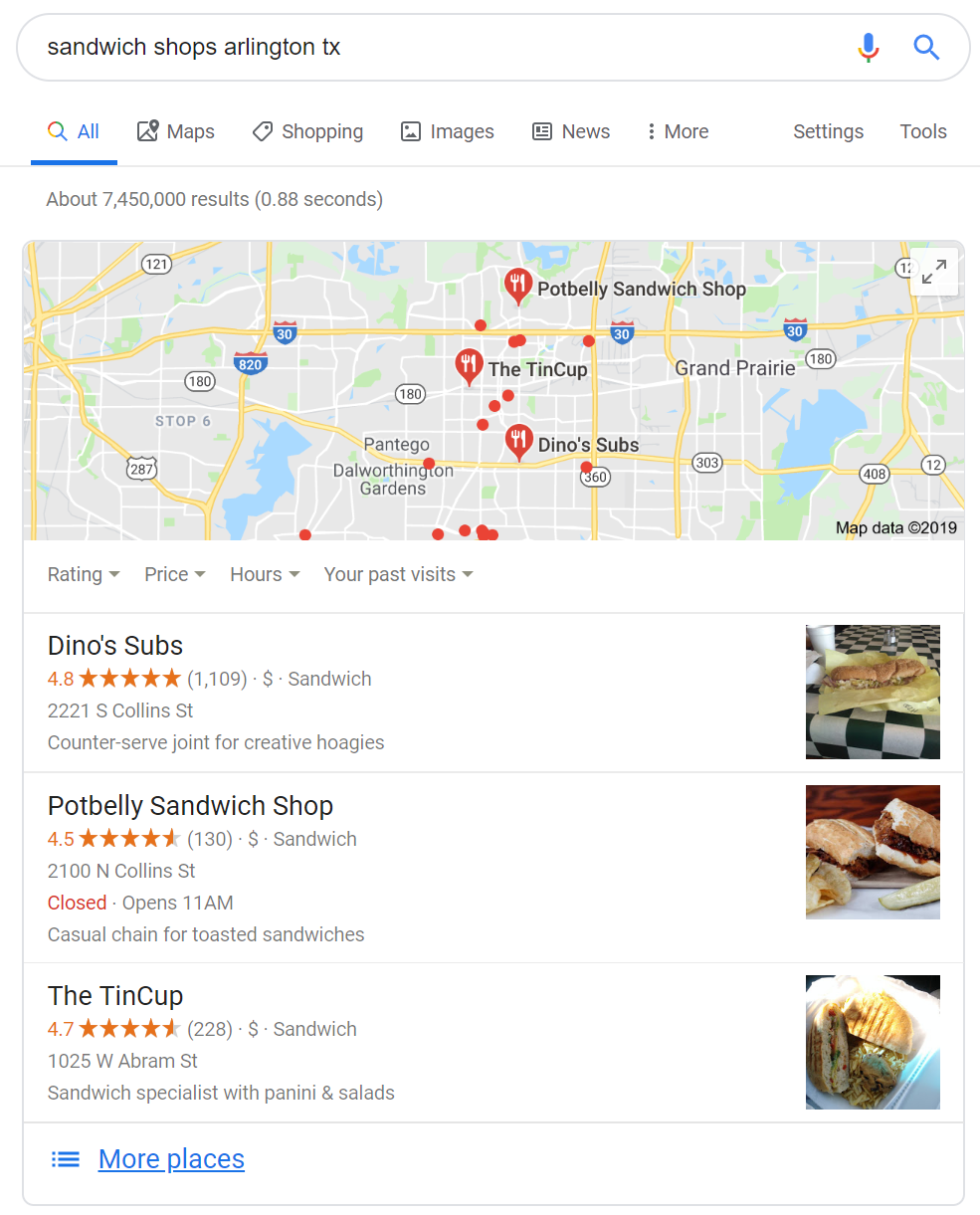
You can see three real shops are listed here. This is because Google has their name, address and phone (also known as NAP) information. It also displays their current average customer rating in Google and possibly Yelp.
The NAP is important. Google looks for consistency here. You should always make sure your local citations are correct. If you spot an incorrect address or phone number listed if can spell disaster as they may be used instead of the correct information.
This is why the GrubHub proxy phone numbers are particularly bad. They are extra numbers associated with a restaurant and can be picked up for the map pack information. Since most searches will use the map pack data to connect with you, they will call the GrubHub number, not yours.
This wont' happen 100% of the time, but you should stay on top of this. One way is to make sure you are listed in as many directories as possible. There are literally hundreds of these sites and services and it can take time. That is why we offer it as part of our local SEO services.
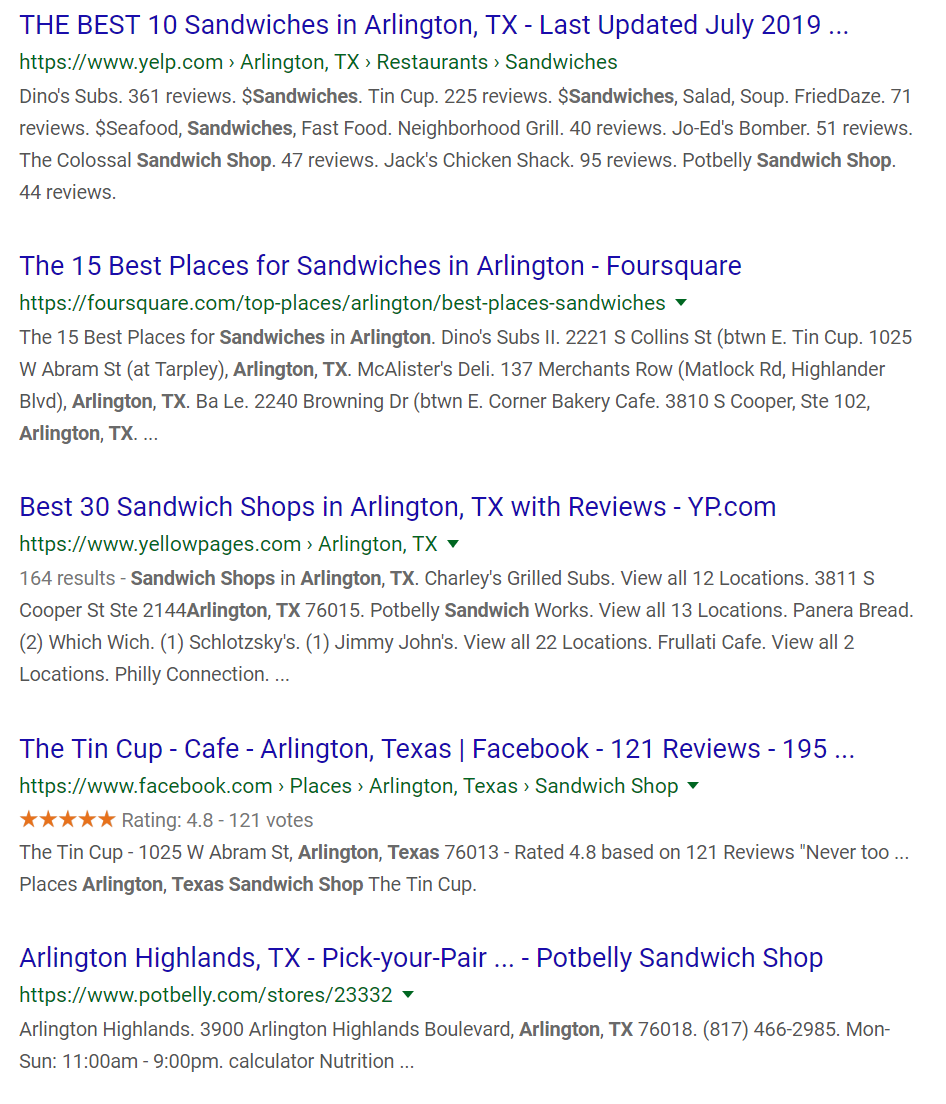
When your correct phone number is listed 50 times across the Internet it will drown out the proxy number in most instances.
You knew there was more. When you click the link the Dino's website is not displayed, it is a more detailed Google listing card along with a list of competing sandwich shops.

Something that stands out to me here and in many of the Google details, is the lack of a real website. There is nothing listed here to take me to a real online presence for Dino's. A missed opportunity in my opinion.
The Potbelly listing does the same thing, listing the DoorDash site as the location's website. Hello commissioned sales.
OK, so let's move past the map pack to the real results. Here we are met with a wall of directories like Yelp, Foursquare (that's still a thing?) and yes, our online ordering platforms.
The 5th result is the Potbelly franchise's store page! Yeah, now we have traction!
Sadly no one will really scroll this far down the results. There will be a few that move down the results and visit the page.
Now for the dirty secret. Ranking for this term is rather easy.
Notice the first result is a Yelp list? The list is really their directory, but is disguised as an article. The page has no external backlinks and ranks for about 100 monthly searches a month.
This means the content is weak and can be crushed with a little effort. That effort could lead to an extra 5-10 orders a month.

Evaluating the Arlington sandwich keywords all have a 0 Ahrefs keyword difficulty score. This basically means earning a handful of links to a website can juice you to the top of the list. Also making sure your page has all the basic technical aspects in order means you most likely cannot be beat.
You can easily outrank any of these larger brands with a minimal amount of effort. A hour or so of intentional effort can not only earn you those extra diners, but you will not be beholden to sales commissions and have a direct relationship with the diner.
Claiming Your Domain
According to the responses and articles I have read on the GrubHub situation the company says they are happy to transfer the domains to the restaurant's ownership.
“GrubHub has never cybersquatted, which is identified by ICANN as ‘generally bad faith registration of another person’s trademark in a domain name.’ As a service to our restaurants, we have created microsites for them as another source of orders and to increase their online brand presence. Additionally, we have registered domains on their behalf, consistent with our restaurant contracts. We no longer provide that service and it has always been our practice to transfer the domain to the restaurant as soon as they request it.”
Of course that may be simpler said than done. According to at least one experience I read about they obfuscate the process so much the owner's simply gave up.
This may be some of GrubHub's doing, but it may be attributed to the ownership transfer process in place with ICANN.
There are several steps that must be taken to change domain ownership.
When a domain is registered there are at least three contacts provided: Admin, Technical, Owner and possibly Billing. The most important record is the Owner of record. Once you have that one you can update the others.
The other records associated with a domain are the name servers. These are the traffic cops of the Internet and are responsible for translating the words we use for domains to computer IP addresses.
A domain has at least 2 name servers, and often 4 or more. Multiple name servers provide redundancy and distribution. Ultimately, they are used to direct requests from the visitor's computer or phone to your web server.
If you can change the ownership and name-server records to your information and web server you have done the difficult work.
The actual process does involve some steps and my experience says most business types get confused and frustrated. I often wind up just handling the process for them through forwarded e-mails. There is typically a code you need to confirm the transfer and a portal you must login to enter the code.
Sometimes business owners must contact the domain registrar directly and provide photo ID and more. I see this often when an employee charged with managing domains leaves a company and no one realized they needed to change the contact records.
In situations where a company has registered a domain on behalf of their customer, like GrubHub has (and I am not saying they are making things difficult, I honestly don't know yet), they can make it difficult to transfer the ownership. You may need to go to the next level and pursue legal action.
To be honest it is probably not worth it unless you are recognized by that domain as a primary source of traffic. Honestly the GrubHub domains for these shadow sites were typically variations of the real domain, location or different TLDs. They are a nice to have.
I do recommend you at least attempt to assume control of these domains. You can then redirect any traffic from those URLs to your real website. The shadow site of course will gradually be deindexed from search results, but any backlinks to that site will now transfer to your website, making it a little stronger in the eyes of Google and Bing.
Retaining Direct Customers
Restaurants are no different than any other business. Earning a new customer is expensive. Earning a repeat customer is far cheaper. Make sure you keep online visitors inside your control by reengaging them to bring them back to your establishment.
This means you may need to offer incentives to join a newsletter, but the payoff can be more than worth it. A free appetizer or soft drink may be all it takes. Consider the initial acquisition costs compared to the cost of sending an e-mail, SMS or push notification.
Online directories and ordering platforms are doing the same thing. It is in their best interest to make sure customers continue to order using their platforms, where they earn those commissions.
You can do the same. Use your own online ordering platform to retain customers. You can do this by allowing them to save orders that can be ordered using a single tap or text message. You can also offer them specials directly through email, SMS and native push notifications.
Some restaurants go as far as inserting fliers in their to go orders encouraging direct, repeat orders. You can also use printed receipts, your street signs and any other opportunity to engage your customers and potential customers.
Summary
Is the GrubHub practice shady or unethical?
Well it straddles the line. They did disclose to restaurants they would be creating the ghost sites, it was just buried deep in their contract.
Can restaurant owners fight back? Of course!
Instead of expressing defeat or frustration with the big dog taking market share, restaurants of all sizes should have the confidence they can compete. That is one of the beautiful features of the web, a level playing ground.
Unfortunately, most restaurant owners, whether they are a small mom and pop, large franchise group or investment group focus on their core business, making great food and delighting customers with friendly service and atmosphere.
The web is technical and has all sorts of scary acronyms that can make many in the hospitality and service industry wilt and give in.
A little effort can go a long way. Most restaurant websites are pretty weak, which is why the GrubHub doppelgangers as well as other directory service landing pages rank well if not better than an establishment's own site.
You may not need a John Taffer or Robert Irvine to come in for a complete makeover, but some simple technical upgrades, adding some content and reaching out for links can go a long way.
This is something Love2Dev specializes in, creating online web presence by tackling the technical and online marketing so business owners can focus more on what they do best.
Restaurants should also invest in nurturing direct relationships with customers. Having them reorder and do so by calling directly or through your own ordering platform can drastically increase your margins.
If GrubHub has created a site for your business you should reach out to them and have them transfer ownership of the domain to you. Create a 301 redirect from that domain to your primary domain. Remember they have accumulated some backlinks, which can strengthen your own site.
This should serve as a wake-up call for restaurant owners everywhere to take more control of their online engagement to increase their profit margins.
You may not be able to eliminate services like GrubHub and Seamless altogether, many consumers prefer using these platforms and that cannot be helped. What you can do is make sure you engage customers directly more often than these platforms do today.
With monthly commissions to these services being in the thousands of dollars cutting them in half can be the difference between profitability and bankruptcy.





